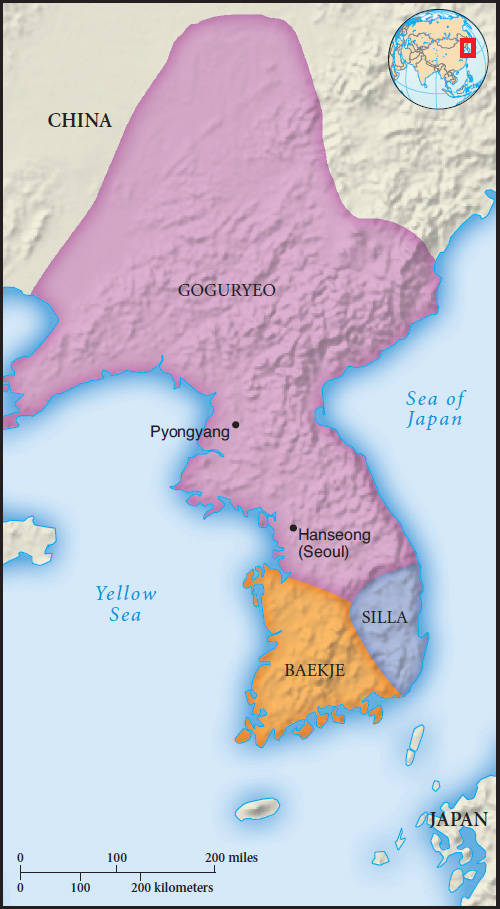Korea and China

Immediately adjacent to northeastern China, the Korean peninsula and its people have long lived in the shadow of their imposing neighbor (see Map 8.2). Temporary Chinese conquest of northern Korea during the Han dynasty and some colonization by Chinese settlers provided an initial channel for Chinese cultural influence, particularly in the form of Buddhism. Early Korean states, which emerged in the fourth through seventh centuries C.E., all referred to their rulers with the Chinese term wang (king). Bitter rivals with one another, these states strenuously resisted Chinese political control, except when they found it advantageous to join with China against a local enemy. In the seventh century, one of these states—the Silla (SHEE-lah) kingdom—allied with Tang dynasty China to bring some political unity to the peninsula for the first time. But Chinese efforts to set up puppet regimes and to assimilate Koreans to Chinese culture provoked sharp military resistance, persuading the Chinese to withdraw their military forces in 688 and to establish a tributary relationship with a largely independent Korea.
Under a succession of dynasties—the Silla (688–900), Koryo (918–1392), and Yi (1392–1910)—Korea generally maintained its political independence while participating in China’s tribute system. Its leaders actively embraced the connection with China and, especially during the Silla dynasty, sought to turn their small state into a miniature version of Tang China.
Tribute missions to China provided legitimacy for Korean rulers and knowledge of Chinese court life and administrative techniques, which they sought to replicate back home. A new capital city of Kumsong was modeled directly on the Chinese capital of Chang’an (chahng-ahn). Tribute missions also enabled both official and private trade, mostly in luxury goods such as ceremonial clothing, silks, fancy teas, Confucian and Buddhist texts, and artwork—all of which enriched the lives of a Korean aristocracy that was becoming increasingly Chinese in culture. Thousands of Korean students were sent to China, where they studied primarily Confucianism but also natural sciences and the arts. Buddhist monks visited centers of learning and pilgrimage in China and brought back popular forms of Chinese Buddhism, which quickly took root in Korea. Schools for the study of Confucianism, using texts in the Chinese language, were established in Korea. In these ways, Korea became a part of the expanding world of Chinese culture, and refugees from the peninsula’s many wars carried Chinese culture to Japan as well.
These efforts to plant Confucian values and Chinese culture in Korea had what one scholar has called an “overwhelmingly negative” impact on Korean women, particularly after 1300.19 Early Chinese observers noticed, and strongly disapproved of, “free choice” marriages in Korea as well as the practice of women singing and dancing together late at night. With the support of the Korean court, Chinese models of family life and female behavior, especially among the elite, gradually replaced the more flexible Korean patterns. Earlier, a Korean woman had generally given birth and raised her young children in her parents’ home, where she was often joined by her husband. This was now strongly discouraged, for it was deeply offensive to Confucian orthodoxy, which held that a married woman belonged to her husband’s family. Some Korean customs—funeral rites in which a husband was buried in the sacred plot of his wife’s family, the remarriage of widowed or divorced women, and female inheritance of property—eroded under the pressure of Confucian orthodoxy. So too did the practice of plural marriages for men. In 1413, a legal distinction between primary and secondary wives required men to identify one of their wives as primary. Because she and her children now had special privileges and status, sharp new tensions emerged within families. Korean restrictions on elite women, especially widows, came to exceed even those in China itself.
Still, Korea remained Korean. After 688, the country’s political independence, though periodically threatened, was largely intact. Chinese cultural influence, except for Buddhism, had little impact beyond the aristocracy and certainly did not penetrate the lives of Korea’s serf-like peasants. Nor did it register among Korea’s many slaves, amounting to about one-third of the country’s population by 1100 C.E. A Chinese-style examination system to recruit government officials, though encouraged by some Korean rulers, never assumed the prominence that it gained in Tang and Song dynasty China. Korea’s aristocratic class was able to maintain an even stronger monopoly on bureaucratic office than their Chinese counterparts. And in the 1400s, Korea moved toward greater cultural independence by developing a phonetic alphabet, known as hangul (HAHN-gool), for writing the Korean language. Although resisted by conservative male elites, who were long accustomed to using the more prestigious Chinese characters to write Korean, this new form of writing gradually took hold, especially in private correspondence, in popular fiction, and among women. Clearly part of the Chinese world order, Korea nonetheless retained a distinctive culture as well as a separate political existence.